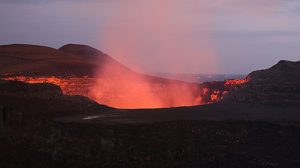
The volcano has a long history of activity and became active again just six months ago. Ashish noted that a team of National Geographic scientists were on hand and would be descending by cable into the caldera the next day.
Only about 30 years after Christopher Columbus arrived to America in 1492 did the Spanish begin their conquest of Nicaragua. At that time, the Masaya and the Momotombo volcanoes were erupting simultaneously. This was the first time early Spaniards witnessed the volcanic activity in the New World. The caldera formed some 2,500 years ago.
From the beginning, they called this volcano the mouth of hell, or Infierno de Masaya. This name followed the tradition of the earlier aboriginal people who believed that the Masaya Volcano was a god. They made offerings and human sacrifices during seasons of drought. Also, the aboriginal chiefs of the region, when solving important matters, asked for “secret advice” of a sorceress who was said to appear inside the volcano.
It is thought that this sorceress of the volcano was a god but similar to the image the Spanish had of the Devil. This added to the idea that all aboriginal gods were products of the Devil.
In 1529, Mercedarian Fray Francisco de Bobadilla climbed the volcano, where he erected a cross in order to exorcise what he called “The Mouth of Hell.” The cross was also used for exorcism rituals. You can visit Bobadilla cross today.
In 1979, Masaya became Nicaragua’s first national park. Masaya Volcano National Park has an area of 54 km² includes two volcanoes and five craters. It is the only volcano in the western hemisphere where you are able to drive to the rim. In the park, an underground tunnel formed by lava flows is home to bats.
Incorporate a volcano experience into our 8-day Gems of Nicaragua.